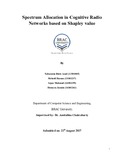| dc.contributor.advisor | Chakrabarty, Dr. Amitabha | |
| dc.contributor.author | Azad, Tabassum Binte | |
| dc.contributor.author | Hassan, Mehedi | |
| dc.contributor.author | Mahmud, Sejan | |
| dc.contributor.author | Jasmin, Humyra | |
| dc.date.accessioned | 2018-01-04T05:05:09Z | |
| dc.date.available | 2018-01-04T05:05:09Z | |
| dc.date.copyright | 2017 | |
| dc.date.issued | 8/21/2017 | |
| dc.identifier.other | ID 13301085 | |
| dc.identifier.other | ID 13101237 | |
| dc.identifier.other | ID 14101259 | |
| dc.identifier.other | ID 14101261 | |
| dc.identifier.uri | http://hdl.handle.net/10361/8914 | |
| dc.description | Cataloged from PDF version of thesis report. | |
| dc.description | Includes bibliographical references (page 41-43). | |
| dc.description | This thesis report is submitted in partial fulfillment of the requirements for the degree of Bachelor of Science in Computer Science and Engineering, 2017. | en_US |
| dc.description.abstract | In the era of spectrum allocation Cognitive Radio (CR) is a favorable solution to the lack of spectrum which is static for each type of communication device and operator causes the waste of a lot of idle spectrum. So that, Significant amount of research are focused on the application of game theory in effective spectrum allocation problem in cognitive radio. Proper utilization of spectrum is needed where the demand of the wireless communication rate is increasing. For fairly distributing those spectrum to unlicensed user by CR without creating interference to authorized users here we will provide a large content or scope to give a better allocation model based on Shapley Value of cooperative Game theory, which will contribute a detail inspection of flexible and logical spectrum allocation in wireless networks through general infrastructure. In this paper, shapely value algorithm has been applied for dynamic network where both authorized and unauthorized users can utilize the radio frequency at the same time with maximum throughput without interfering the authorized users. The allocation process is allowed only when a spectrum has been requested and idle spectrum is present in the network. Fair policy in the spectrum for the unauthorized users has been ensured with a universal price function. Here, results of the proposed method has been compared with other game theory’s (VCG model, Cournot , Bertrand) which have been applied for spectrum allocation in cognitive radio. | en_US |
| dc.description.statementofresponsibility | Tabassum Binte Azad | |
| dc.description.statementofresponsibility | Mehedi Hassan | |
| dc.description.statementofresponsibility | Sejan Mahmud | |
| dc.description.statementofresponsibility | Humyra Jasmin | |
| dc.format.extent | 43 pages | |
| dc.language.iso | en | en_US |
| dc.publisher | BRAC University | en_US |
| dc.rights | BRAC University thesis are protected by copyright. They may be viewed from this source for any purpose, but reproduction or distribution in any format is prohibited without written permission. | |
| dc.subject | Cognitive radio | en_US |
| dc.subject | Spectrum | en_US |
| dc.subject | Shapley value | en_US |
| dc.title | Spectrum allocation in cognitive radio networks based on shapley value | en_US |
| dc.type | Thesis | en_US |
| dc.contributor.department | Department of Computer Science and Engineering, BRAC University | |
| dc.description.degree | B. Computer Science and Engineering
| |

